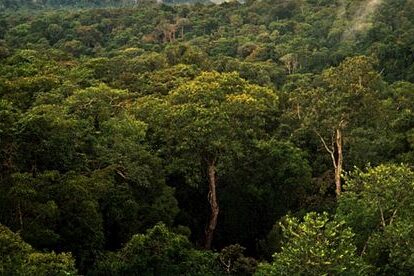
Drought and human activity ‘degrading more than a third of the Amazon rainforest.’
According to the findings of the study, water scarcity, fires, conversion of land, logging, and fires have reduced the forest’s resilience.
According to a study, drought and human activity may have degraded more than a third of the Amazon rainforest, which is twice the previous estimate. This raises concerns that the ecosystem, which is important to the world, is slipping toward a point where there is no going back.
Up to 2.5 million square kilometers (ten times the size of the United Kingdom) of the forest’s resilience has been weakened by fires, conversion of land, logging, and a lack of water. The authors warn of “megafires” in the future because this region is now dryer, more flammable, and more vulnerable than it was before.
According to the findings of the paper, between 5.5% and 38% of the world’s largest remaining tropical forest is also less capable of regulating the climate, producing rainfall, storing carbon, providing a habitat for other species, providing a means of livelihood for locals, and maintaining itself as a viable ecosystem.
Brazil has pushed back its agricultural and mining frontiers over the past half century to meet the demands of an increasingly wealthy, more populous, and high-consumption world. In addition, 17% of the original forest has been completely cleared.
A zero-deforestation policy has been pledged by Luiz Inácio Lula da Silva, the new president of Brazil. However, the authors assert that work on degradation is also required to prevent megafires in the future.
“There is hope now, but our paper shows it is not enough to resolve deforestation. There is much more work to be done,” said Jos Barlow, of Lancaster University.
An international team of 35 scientists and researchers from institutions like the University of Campinas (Unicamp) in Brazil, the Amazon Environmental Research Institute (IPAM), the National Institute for Space Research (INPE), and Lancaster University in the United Kingdom conducted a review of previous studies, analysed recent satellite data, and conducted a new assessment of the effects of drought.
The majority of the increase in Amazon degradation compared to the previous estimate of 17% is attributed to water scarcity. Due to the fact that drought makes forests more susceptible to fire and reduces their capacity to regenerate themselves through evapotranspiration—the process by which trillions of plants produce rainclouds—by up to 34%, drought is a growing cause for concern.
This has ripple effects throughout a larger region, including food-producing regions that rely on the “flying rivers” of the Amazon to water crops. Worst of all, it raises the possibility of a destructive feedback loop in which drought reduces the capacity of the forest to pump water, resulting in further drought.
The authors urge policymakers to prioritise reducing the causes of degradation and treating it as a priority alongside the more well-known issue of deforestation in order to stop these risks from spiralling out of control. In terms of visibility, the two differ significantly. Deforestation is when all of the forest is cut down and the land is used for other things, which satellites can easily identify. Degradation, on the other hand, is the partial loss of vegetation caused by human activity that occurs beneath the canopy of larger trees and is frequently hidden.
The distinction is as stark as the one between having your hair completely shaved off and having it thinned. However, degradation has a greater impact than localised deforestation because it affects a much larger area. According to the paper, degradation could even produce more carbon emissions than deforestation.
Because degradation is difficult to measure and define, the authors acknowledge that their estimates contain a significant amount of uncertainty. The wide range of estimates for the affected area reflects this: from 5% if only fire, logging, and edge effects are taken into account, to 38% if drought effects are also taken into account.
There is uneven distribution of the effects on society. The majority of the economic benefits that come from logging and clearing land are distributed to cities in other countries. In contrast, indigenous and other forest communities suffer the majority of the negative effects, including the loss of forest products, worsening air quality, and deteriorating water quality.
When a forest becomes so degraded that the locals abandon it, Barlow warns of socioeconomic tipping points, which means less protection against extractive industries.
The paper’s authors advise policymakers to increase degradation monitoring, improve fire fighting capabilities, reduce logging, and plant buffer zones in secondary forests to safeguard the original vegetation’s exposed borders.
The findings were published in Science.
——————————————————————————
At Natural World Fund, we are passionate about stopping the decline in our wildlife.
The declines in our wildlife is shocking and frightening. Without much more support, many of the animals we know and love will continue in their declines towards extinction.
When you help to restore a patch of degraded land through rewilding to forests, meadows, or wetlands, you have a massive impact on the biodiversity at a local level. You give animals a home and food that they otherwise would not have had, and it has a positive snowball effect for the food chain.
We are convinced that this is much better for the UK than growing lots of fast-growing coniferous trees, solely to remove carbon, that don’t actually help our animals to thrive.
This is why we stand for restoring nature in the UK through responsible rewilding. For us, it is the right thing to do. Let’s do what’s right for nature!
Support our work today at https://naturalworldfund.com/ and join in the solution!

